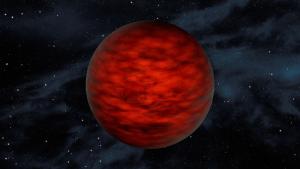Lone Planetary-Mass Object Found in Family of Stars
In 2011, astronomers announced that our galaxy is likely teeming with free-floating planets. In fact, these lonely worlds, which sit quietly in the darkness of space without any companion planets or even a host sun, might outnumber stars in our Milky Way galaxy. The surprising discovery begged the question: Where did these objects come from? Are they planets that were ejected from solar systems, or are they actually light-weight stars called brown dwarfs that formed alone in space like stars?

A young, free-floating world sits alone in space in this illustration. The object, called WISEA J114724.10?204021.3, is thought to be an exceptionally low-mass "brown dwarf," which is a star that lacked enough mass to burn nuclear fuel and glow like a star.
A new study using data from NASA's Wide-field Infrared Survey Explorer, WISE, and the Two Micron All Sky Survey, or 2MASS, provides new clues in this mystery of galactic proportions. Scientists have identified a free-floating, planetary-mass object within a young star family, called the TW Hydrae association. The newfound object, termed WISEA J114724.10-204021.3, or just WISEA 1147 for short, is estimated to be between roughly five to 10 times the mass of Jupiter.
WISEA 1147 is one of the few free-floating worlds where astronomers can begin to point to its likely origins as a brown dwarf and not a planet. Because the object was found to be a member of the TW Hydrae family of very young stars, astronomers know that it is also very young -- only 10 million years old. And because planets require at least 10 million years to form, and probably longer to get themselves kicked out of a star system, WISEA 1147 is likely a brown dwarf. Brown dwarfs form like stars but lack the mass to fuse atoms at their cores and shine with starlight.
"With continued monitoring, it may be possible to trace the history of WISEA 1147 to confirm whether or not it formed in isolation," said Adam Schneider of the University of Toledo in Ohio.
Of the billions of possible free-floating worlds thought to populate our galaxy, some may be very low-mass brown dwarfs, while others may in fact be bona fide planets, kicked out of nascent solar systems. At this point, the fraction of each population remains unknown. Tracing the origins of free-floating worlds, and determining whether they are planets or brown dwarfs, is a difficult task, precisely because they are so isolated.
"We are at the beginning of what will become a hot field - trying to determine the nature of the free-floating population and how many are planets versus brown dwarfs," said co-author Davy Kirkpatrick of NASA's Infrared Processing and Analysis Center, or IPAC, at the California Institute of Technology in Pasadena.
Astronomers found WISEA 1147 by sifting through images taken of the entire sky by WISE, in 2010, and 2MASS, about a decade earlier. They were looking for nearby, young brown dwarfs. One way to tell if something lies nearby is to check to see if it's moved significantly relative to other stars over time. The closer an object, the more it will appear to move against a backdrop of more distant stars. By analyzing data from both sky surveys taken about 10 years apart, the close objects jump out.
Finding low-mass objects and brown dwarfs is also well suited to WISE and 2MASS, both of which detect infrared light. Brown dwarfs aren't bright enough to be seen with visible-light telescopes, but their heat signatures light up when viewed in infrared images.
The brown dwarf WISEA 1147 was brilliantly "red" in the 2MASS images (where the color red had been assigned to longer infrared wavelengths), which means that it's dusty and young.
"The features on this one screamed out, 'I'm a young brown dwarf,'" said Schneider.
After more analysis, the astronomers realized that this object belongs to the TW Hydrae association, which is about 150 light-years from Earth and only about 10 million years old. That makes WISEA 1147, with a mass between about five and 10 times that of Jupiter, one of the youngest and lowest-mass brown dwarfs ever found.
Interestingly, a second, very similar low-mass member of the TW Hydrae association was announced just days later (2MASS 1119-11) by a separate group led by Kendra Kellogg of Western University in Ontario, Canada.
Another reason that astronomers want to study these isolated worlds is that they resemble planets but are easier to study. Planets around other stars, called exoplanets, are barely perceptible next to their brilliant stars. By studying objects like WISEA 1147, which has no host star, astronomers can learn more about their compositions and weather patterns.
"We can understand exoplanets better by studying young and glowing low-mass brown dwarfs," said Schneider. "Right now, we are in the exoplanet regime."
Source: Jet Propulsion Laboratory
- 370 reads
Human Rights
Ringing FOWPAL’s Peace Bell for the World:Nobel Peace Prize Laureates’ Visions and Actions

Protecting the World’s Cultural Diversity for a Sustainable Future

The Peace Bell Resonates at the 27th Eurasian Economic Summit

Declaration of World Day of the Power of Hope Endorsed by People in 158 Nations

Puppet Show I International Friendship Day 2020

